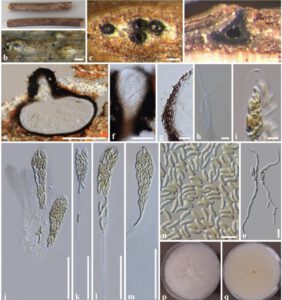Allocryptovalsa polyspora Senwanna, Phookamsak & K.D. Hyde, in Senwanna, Phookamsak, Doilom, Hyde & Cheewangkoon, Mycosphere 8(10): 1840 (2017)
Index Fungorum number: IF 553858; Facesoffungi number: FoF03774
Etymology – The epithet “polyspora” refers to the polysporous asci
Holotype – MFLU 17-1218
Saprobic on dead twig of Hevea brasiliensis (Willd.) Muell. Arg. Sexual morph: Ascostromata solitary to gregarious, 1–3-loculate, immersed to semi-immersed, becoming raised to erumpent through the host tissue. Ascomata 100–400 µm diam., 80–425 µm high, perithecial, dark brown to black, gregarious or solitary, immersed to semi-immersed in substrate, globose to subglobose, dark brown to black, ostiolate, papillate. Ostiolar canal 20–40 µm wide, central, not prominent, cylindrical, straight, dark brown to black, with periphysate. Peridium 15–33 μm wide, composed of two type layers, outer layer comprising several layers of thick-walled, dark brown to black cells of textura angularis, inner layer comprising 3–5 layers of thin-walled, hyaline cells of textura angularis. Hamathecium 3–10 μm wide, comprising dense, hyaline, septate, unbranched, slightly constricted at the septa, filamentous paraphyses, tapering towards the apex. Asci (33–)70–120(−177) × (4–)13–19(−21) µm (x̄ = 104 × 16.3 μm, n = 20), spore-bearing part length [p. sp.] (29–) 40–75(−90) μm (x̄ = 59.73 μm, n = 45), polysporous, unitunicate, thin-walled, clavate, long pedicellate, apically rounded, with a refractive, J- subapical ring. Ascospores 5–14 × 2–4 µm (x̄ = 10.8 × 2.8 μm, n = 105), crowded, pale yellowish to pale brown at maturity, oblong to allantoid, aseptate, slightly curved, smooth-walled, with small guttules. Asexual morph: Undetermined.
Culture characteristics – Ascospores germinated on MEA within 24 hours and germ tube produced from one or both sides of the ascospore. Colonies on MEA reaching 5.5 cm diam. after 14 days at 25 °C, colonies medium dense, irregular, flat or effuse, slightly raised, fluffy, white, not produced pigmentation on MEA media.
Material examined – THAILAND, Phayao Province, Muang District, on dead twig of Hevea brasiliensis (Euphorbiaceae), 29 January 2017, C. Senwanna, RBPY046 (MFLU 17-1218, holotype, HKAS100697 isotype), ex-type living culture, MFLUCC 17-0364 = KUMCC17-0261.
Addition GenBank number – LSU = MF959503.
Notes – Allocryptovalsa polyspora shares a size range of the asci and ascospores with A. cryptovalsoidea, but is typical smaller than A. cryptovalsoidea and A. rabenhorstii. However, A. polyspora differs from A. cryptovalsoidea and A. rabenhorstii in a having shorter of spore-bearing part.

Figure 1 – Allocryptovalsa polyspora (MFLU 17-1218, holotype). a–b Habit of ascostromata on substrate. c Transverse sections through ascostroma. d Vertical section through ascostroma. e Section through the ascoma. f Ostiole with short periphyses. g Peridium. h Paraphyses. i Refractive J- subapical ring. j–m Asci. n Ascospores. o Germinated ascospores. p–q Culture characteristic on PDA after 14 days (p = colony from above, q = colony from below). Scale bar: b = 200 µm, c, d, e = 100 µm, f, j–m = 50 µm, g–i = 20 µm, n–o = 10 µm.
